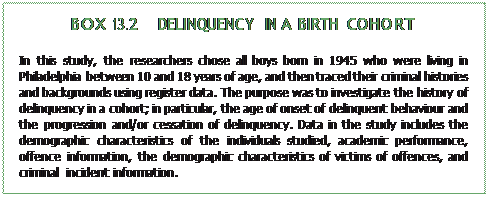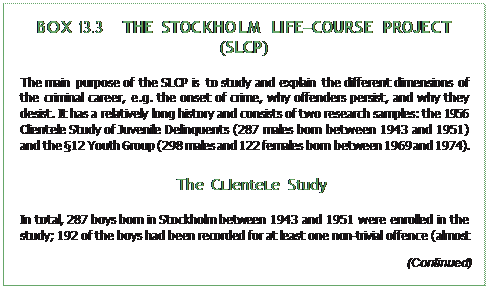 |
Prospective and retrospective designs
|
|
|
|
Longitudinal research can be of two kinds: prospective and retrospective (Blumstein et al., 1986). Prospective longitudinal designs are forward-looking. You take a sample of individuals, usually defined by age (a whole cohort, or a sample defined by some other criteria), and then follow that sample repeatedly over their life course, or some part of it. As you go along, you make repeated measurements of the same factors or variables that you are interested in. So, say, you take a sample of 8-year-old children and follow them to the age of 38, making new data collections every second year.
The primary advantage of the prospective design is obvious: you collect data on events relatively soon after they have occurred, and this way you manage to avoid the memory problem: it is likely that an 18-year-old can provide a better picture of what her high school experience is like than she would if she was interviewed at the age of 26, since what she experienced during her high school years may be affected by later life events. By using a prospective design, you also have better control over the crucial dimension of time. You can identify what comes first: does drug use precede low attachment to the labour market in adult- hood, or does low attachment to the labour market precede drug use? The Cambridge Study of Delinquent Development is an example of this prospective approach (Box 13. 1).
 BOX 13. 1 THE CAMBRIDGE STUDY OF DELINQUENT DEVELOPMENT
BOX 13. 1 THE CAMBRIDGE STUDY OF DELINQUENT DEVELOPMENT
A sample of 411 South London boys, mostly born in 1953, were enrolled in the study. The sample consisted of all the boys aged 8–9 who were listed on the registers of six primary schools within a 1-mile radius of a research office that the group, headed by the late Donald West, had established. The study’s original aims sought to trace and understand the development of delinquent and criminal behaviour in inner-city males, explore the possibilities of predicting such behaviours in advance, and to explain the waxing and waning of crime across the life course. Rather than aim to test any specific theory, the research group wanted to test many different hypothe- ses about the causes and correlates of crime.
The research group collected extensive data on each male, including surveys and interviews, psychological tests, and interviews with the males’ parents and teachers. Part of the reason for casting a wide net at the beginning of the study, in terms of variables and measurements, was that criminology is a changing discipline, in terms of perspectives, theory and method.
Since the start, the 411 males had then been continuously followed up roughly every other year, using register data and interviews, beyond age 50. The study fol- lows up the boys’ development with respect to many different life areas from children to adult men, and inter alia studies of how these factors affect their crime, addiction and other criminologically relevant factors. Eventually, the study also included the children of the investigated persons.
|
|
|
The primary disadvantage of the prospective design is obvious: if you want to explore the life courses of a sample from age 8 to 38, it takes 30 years. If you want to make repeated measurements every other, or every third or fourth year, it consumes a
 lot of resources, both in terms of personnel and money. And not only that – by the time you have followed the sample to age 38, 30 years have passed, and that amount of time can do a lot to a society, and to the sciences – what if the results you now have are no longer relevant? Not to mention the fact that you yourself get old!
lot of resources, both in terms of personnel and money. And not only that – by the time you have followed the sample to age 38, 30 years have passed, and that amount of time can do a lot to a society, and to the sciences – what if the results you now have are no longer relevant? Not to mention the fact that you yourself get old!
The other design is retrospective, a design that looks backwards rather than for- ward. Typically, a sample is selected based on some criteria or other, such as adult inmates who serve time in a prison in a given year. Having done so, the researcher traces their backgrounds and past experiences, using register data and/or interviews. This was the design Wolfgang, Figlio and Sellin (1972) used in their famous Delinquency in a Birth Cohort.
 |
The main advantage of this design is that it avoids the time-consuming step-by- step exploration of the unfolding of the lives of the sample, as they have to do in the Cambridge study. It is thus much more economical. There is, of course, a problematic issue here as well, constituting the main disadvantage of the retrospective design. It once again has to do with the issue of time, in two ways.
Some studies only include official register data. This is perhaps more common in the Nordic and some other European countries, because the quality of their official records tends to be good and such data is available to the researchers (Skardhamar and Lyngstad, 2011). However, the longer we go back in time, the more unstable the records usually become. In addition, the way data is collected, and the content of what is collected, can change: some data series cease, others start. There may be problems with the different data series’ compatibility.
To give just one example, in a research project we, the authors, conducted the Stockholm Life-Course Project (see Carlsson and Sarnecki, 2015), we wanted to under- stand and explain the criminal histories of a Swedish sample born in the 1940s and 1950s, and the possibilities and problems of predicting future criminal careers from
early risk factors and indicators of antisocial behaviour. In this study, we therefore combined register data, interviews, different types of medical and psychological tests and questionnaires. Interviews were both structured and semi-structured and included not only the individuals studied but, in some parts, also their parents and teachers.
In Swedish crime registers, we not only had to handle the problem of using two dif- ferent sets of crime registers – police records, which are available until the 1980s, and conviction records, which are available from the mid-1970s. We also had to take into account the sorting-out process that takes place within these police records, where indi- viduals once recorded for crimes were sorted out if they were not recorded for a new offence, as the authorities only had the right to keep them for a certain amount of time. These records still exist, at the Swedish National Archive, but must then be added to the ‘original’ records to provide a full picture of their criminal histories. Other records – such as those kept by the Social Services – also change over time, with new variables replacing older ones, and so on. This makes a longitudinal analysis difficult, because at different points in time we may in fact capture, or measure, partly different things.
|
|
|
Second, if we do not – or not only – rely on register data, we are likely to rely on interviews in some way (we elaborate on life history interviews below). If we do these retrospectively, we sometimes ask the interview participant to recall events and expe- riences which occurred a long time ago, making the crucial sequencing of life events difficult to pin down. Recalling what came first – starting to smoke marihuana or skipping school at the age of 15 – may be very difficult 30, 40 or 50 years later. In retrospective interviews, we also, of course, miss all the people who cannot be inter- viewed, since they may be dead or, for other reasons, impossible to reach.
 |

(Continued)
exclusively theft) prior to the age of 15, and constituted the delinquent group. The remaining 95 boys constituted a matched control group. They were matched on age, social group, family type and neighbourhood type, but had no known criminal history. The low number of cases was compensated for by the extensive and interdisci- plinary studies conducted on each boy. The original study comprised around 2, 000 variables. Different teams (medical, psychiatric, psychological and sociological) col- lected a variety of data using an array of methods. For example, the sociological study included interviews with the boys’ parents, teachers, the Clientele boys them- selves, as well as register data, whereas the data in the psychiatric and psychological parts was obtained almost exclusively through judgements of the research personnel and different kinds of tests. The boys’ recorded and self-reported
delinquency was also included.
Sarnecki conducted a follow-up study of the Clientele boys, who were by then approaching middle age. The delinquent group was divided into two groups: D1 (n = 131) and D2 (n = 61). In the D1 group, every boy was known by the police to have committed one crime prior to age 15. In the D2 group, the boys were known by the police to have committed two or more crimes prior to age 15. Sarnecki collected register data on the 287 men’s health (including mortality), education and employ- ment history, criminal history, drug use and household status, among other things.
The § 12 Youth Group
The study was originally based on a Stockholm sample of women and men (n = 420) born between 1969 and 1974. Of these, 298 were male and 122 were female. From 1990 to 1994 they were subject to interventions by the Swedish Social Services under the Care of Young Persons (Special Provisions Act) for residential treatment in so-called youth homes, or §12 homes then operated by Stockholm County Council.
The 2010 study
In 2010, we launched a new follow-up of the two samples. We had access not only to data from the original studies, but also to the data Sarnecki collected on the Clientele boys in the 1980s. In our follow-up, we collected new, extensive register data on both samples, including criminal records, health and medical records, employment history, relationship history and many other things.
We also conducted new, long, life history interviews with a subset of the samples, aiming for depth rather than breadth, setting our goal to 30 Clientele interviews, that is, slightly more than 10% of the total original sample. In total, we conducted inter- views with 30 men, drawing cases from the D1, D2 and control groups to get variation.

|
|
|


